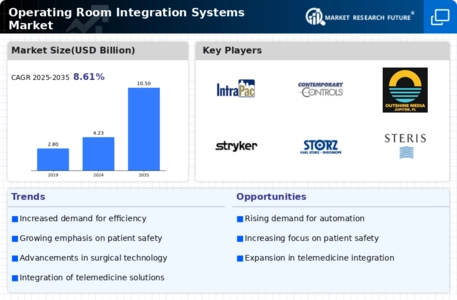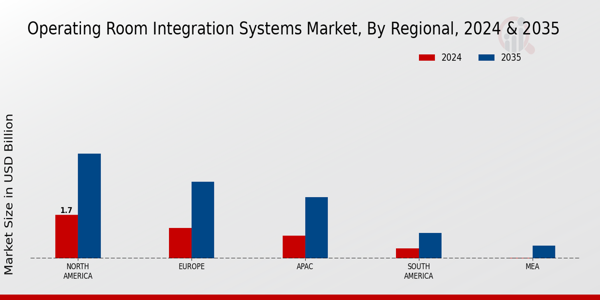Market Analysis
In-depth Analysis of Operating Room Integration Systems Market Industry Landscape
The Surge in Surgical Procedures
In recent times, there has been a noticeable surge in the prevalence of chronic diseases globally. This rise has consequently fueled a substantial demand for therapeutic surgical interventions encompassing a wide spectrum, including bariatric, orthopedic, and cardiovascular surgeries. An insightful report, the Fifth Annual Report of the Bariatric Surgery Registry, jointly published by Monash University and the Obesity Surgery Society of Australia & New Zealand in 2017, revealed a significant surge in patient participation in the bariatric surgery registry. The statistics exhibited a noteworthy escalation from 15,643 participants in 2016 to an impressive 28,308 in 2017. Such pronounced trends in surgical interventions, particularly in bariatric surgeries, indicate a compelling increase in the demand for these specialized procedures.
These escalating trends are further accentuated by the substantial surge in healthcare expenditures witnessed across the Asia-Pacific region. This augmentation in healthcare spending has stimulated the development and implementation of advanced integrated operating room management systems. Present-day operating rooms are undergoing a transformative shift, evolving into high-tech arenas equipped with an array of sophisticated tools and technologies. These modernized spaces boast multiple surgical displays, cutting-edge image capturing devices, state-of-the-art camera systems, communication system monitors, and medical printers. Alongside these modern advancements, traditional equipment such as side booms, surgical tables, surgical lighting, and room lighting continue to play integral roles in these revamped operating environments.
The upsurge in surgical procedures witnessed across the Asia-Pacific region is anticipated to be a pivotal driving force behind the growth trajectory of the market. The surge in chronic diseases and the subsequent necessity for therapeutic interventions have propelled healthcare facilities in the region to invest significantly in upgrading their surgical infrastructure. This infusion of advanced technologies and sophisticated equipment aims to meet the burgeoning demands for diverse surgical procedures while ensuring precision, efficiency, and improved patient outcomes.
Moreover, this surge in surgical interventions has triggered a paradigm shift in the way healthcare facilities operate, emphasizing the need for integrated systems that streamline and optimize the surgical process. The incorporation of cutting-edge technologies into operating rooms not only enhances the capabilities of healthcare professionals but also contributes to minimizing procedural complexities and maximizing the efficacy of surgical interventions.
The surge in surgical procedures is indicative of a broader trend—advancements in medical technology and evolving healthcare needs are shaping the landscape of healthcare delivery. The evolving nature of surgical interventions necessitates a holistic approach, integrating innovative tools and equipment with traditional essentials to cater to the increasing demands for specialized medical procedures.
The escalating number of surgeries witnessed across the Asia-Pacific region underscores the evolving healthcare landscape and the critical role played by advanced operating room management systems. This surge in surgical interventions reflects the proactive response of healthcare facilities to meet the escalating demands for therapeutic procedures while emphasizing precision, technological integration, and enhanced patient care. The fusion of modern technologies with traditional equipment in these cutting-edge operating rooms reflects the healthcare industry's commitment to innovation and excellence in providing specialized medical care.














Leave a Comment